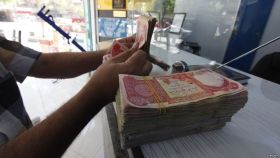An economic study ranked Arab Iraq in the middle-income segment of the Arab citizen. The study prepared by the Arab Organization for Investment Guarantee that “considerable variation observed between the Arab states, which can be classified into four segments, the first high-income very 25.7 thousand to $ 10.7 thousand dollars and includes 5 countries, namely Oman, Saudi Arabia, Bahrain, Libya, Lebanon , then come the middle income bracket of U.S. $ 6.4 thousand to 3.1 thousand dollars and includes six countries, namely, Algeria, Iraq, Jordan, Tunisia, Morocco and Egypt. “
She added, “As for the low-income bracket from 1.6 thousand to 1.1 thousand U.S. dollars and includes 4 countries, namely Djibouti, Sudan, Yemen and Mauritania.” It showed that “the income of the Arab citizen has seen clear growth of 5 thousand dollars a year on average for the period between 2005 and 2009 to 8.2 thousand dollars in 2013 with expectations to continue the improvement to 8.4 thousand dollars.”
Projections indicate further improvement of the income of the Arab citizen to 8.4 thousand U.S. dollars in 2014, and the aggregate output growth rate of more than the Arab population growth rate in the Arab countries during the period. She pointed out that “the results of the study showed a decline of economic activity in the Arab region through the year 2013, where the rate of GDP growth to 3.4% Arab, compared with 3.9% in 2012 with expectations that rises to 5% in 2014.
The study concluded that “the existence of indicators recovery expected this year and the coming years, after a long period of decline and weak growth.” As for the gross domestic product of the Arab countries [19 countries] has increased from 2663 billion dollars in 2012 to 2716 billion dollars during the year 2013, with expectations to continue to rise by 52.7 billion dollars to $ 2853 billion in 2014. “
While the number of people in the Arab countries of the 316.5 million average for the period between 2005 and 2009 to 332.4 million in 2013, with expectations to continue to increase to 339.5 million in 2014. The population in the Arab countries around 5% of the total world population of about 7 billion people by the end of 2013.
alliraqnews.com
